这篇文章将为大家详细讲解有关Java中流怎么用,小编觉得挺实用的,因此分享给大家做个参考,希望大家阅读完这篇文章后可以有所收获。
1.File类的一个对象,代表一个文件或一个文件目录(俗称:文件夹)
2.File了声明在java.io包下
3.File类中涉及到关于文件或文件目录的创建、删除、重命名、修改时间、文件大小等方法。
并涉及到写入或读取文件内容的操作。入宫需要读取或写入文件内容,必须使用IO流来完成。
4.后续File类的对象常会作为参数传递到流的构造器中,指明读取或写入的"终点"。


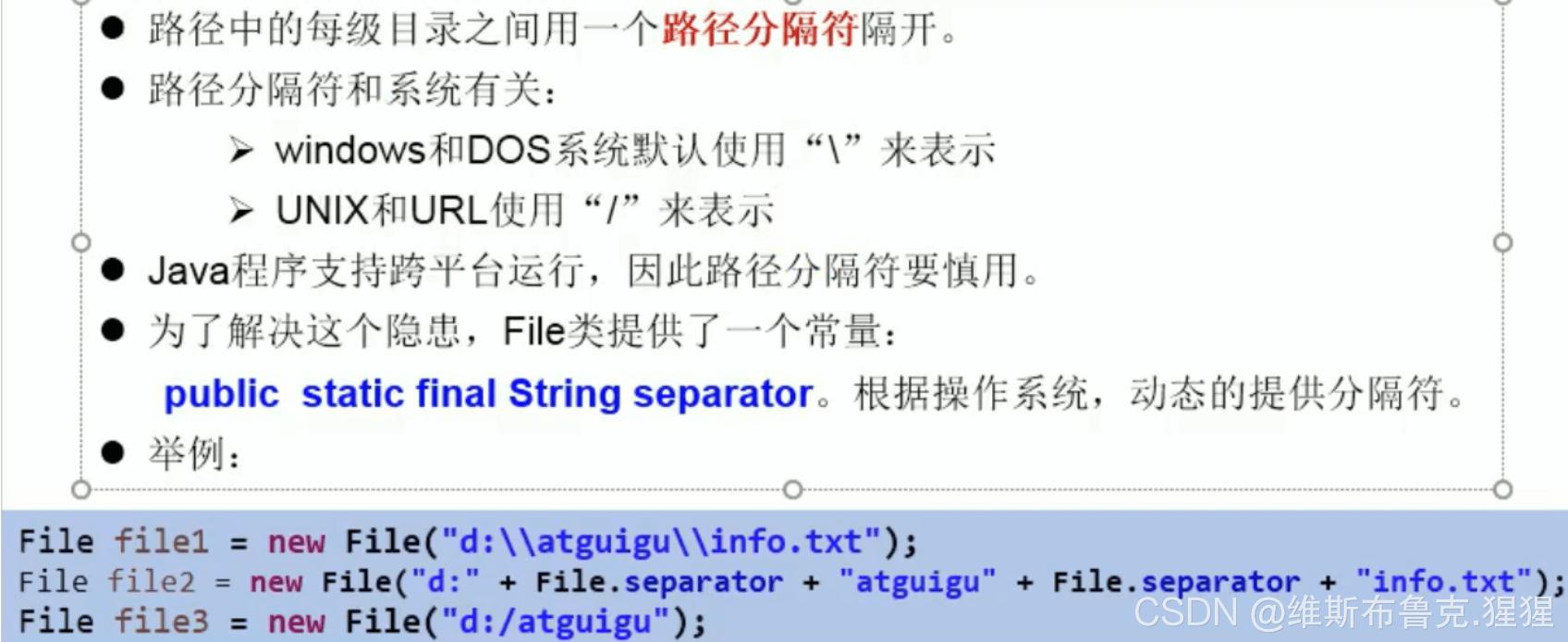
/*
1.如何创建File类的实例
File(String filePath)
File(String parentPath,String,childPath)
File(File parentFile,String childPath)
2.相对路径:相较于某个路径下,知名的路径。
绝对路径:包含盘符在内的未见或文件目录的路径
3.路径分隔符
windows:\\
unix:/
*/
public void test1() {
//构造器1
File file1 = new File("hello.txt");//相对于module
File file2 = new File("E:\\zxdym\\IDEA\\code\\JavaSenior\\2021_08\\he.txt");
System.out.println(file1);
System.out.println(file2);
//构造器2
File file3 = new File("E:\\zxdym\\IDEA\\code", "JavaSenior");
System.out.println(file3);
//构造器3
File file4 = new File(file3, "hi.txt");
System.out.println(file4);
}


public void test2() {
File file1 = new File("hello.txt");
File file2 = new File("d:\\io\\hi.txt");
System.out.println(file1.getAbsolutePath());
System.out.println(file1.getPath());
System.out.println(file1.getName());
System.out.println(file1.getParent());
System.out.println(file1.length());
System.out.println(new Date(file1.lastModified()));
System.out.println();
System.out.println(file2.getAbsolutePath());
System.out.println(file2.getPath());
System.out.println(file2.getName());
System.out.println(file2.getParent());
System.out.println(file2.length());
System.out.println(file2.lastModified());
}
public void test3() {
File file = new File("E:\\\\zxdym\\\\IDEA\\\\code\\\\JavaSenior");
String[] list = file.list();
for (String s : list) {
System.out.println(s);
}
System.out.println();
File[] files = file.listFiles();
for (File f : files) {
System.out.println(f);
}
}
/*
public boolean removeTo(File dest):把文件重命名为指定的文件路径
比如:file1.renameTo(file2)为例:
要想保证返回true,需要file1在硬盘中是存在的,且file2不能在硬盘中存在。
*/
@Test
public void test4() {
File file1 = new File("hello.txt");
File file2 = new File("D:\\io\\hi.txt");
boolean renameTo = file1.renameTo(file2);
System.out.println(renameTo);
}
@Test
public void test5() {
File file1 = new File("hello.txt");
System.out.println(file1.isDirectory());
System.out.println(file1.isFile());
System.out.println(file1.exists());
System.out.println(file1.canRead());
System.out.println(file1.canWrite());
System.out.println(file1.isHidden());
}
@Test
public void test6() throws IOException {
File file1 = new File("hi.txt");
if (!file1.exists()) {
file1.createNewFile();
System.out.println("创建成功");
} else {//文件存在
file1.delete();
System.out.println("删除成功");
}
}
@Test
public void test7(){
//文件目录的创建
File file1 = new File("e:\\io\\io1\\io3");
boolean mkdir = file1.mkdir();
if(mkdir){
System.out.println("创建成功1");
}
File file2 = new File("e:\\io\\io1\\io3");
boolean mkdir1 = file1.mkdirs();
if(mkdir1){
System.out.println("创建成功2");
}
}D.注意点




开发中,用缓冲流,效率比节点流高(蓝色框中的表示重要的、常用的)
A.创建File类的对象,指明读取的数据的来源。(要求此文件一定要存在)
B.创建相应的输入流,将File类的对象作为参数,传入流的构造器中
C.具体的读入过程:
创建相应的byte[] 或 char[]
D.关闭流资源
说明:程序中出现的异常需要使用try-catch-finally处理。
A.创建File类的对象,指明写出的数据的来源。(要求此文件一定要存在)
B.创建相应的输出流,将File类的对象作为参数,传入流的构造器中
C.具体的写出过程:
write(char[]/byte[] buffer,0,len)
D.关闭流资源
说明:程序中出现的异常需要使用try-catch-finally处理。
public class FileReaderWriterTest {
public static void main(String[] args) {
File file = new File("hello.txt");//相较于前工程
System.out.println(file.getAbsolutePath());
File file1 = new File("2021_08\\hello.txt");
System.out.println(file1.getAbsolutePath());
}
/*
将day09下的hello.txt文件内容读入程序中,并输出到控制台
说明点:
1.read()的理解,返回读入的一个字符,如果达到文件末尾,返回-1
2.异常的处理:为了保证流资源一定可以执行关闭操作。需要使用try-catch-finally处理
3.读入的文件一定要存在,否则就会报FileNotFoundException.
*/
@Test
public void testFileReader(){
FileReader fr = null;
try {
//1.实例化File类的对象,指明要操作的文件
File file = new File("hello.txt");//相较于当前Module
//2.提供具体的流
fr = new FileReader(file);
//3.数据的读入
//read():返回读入的一个字符,如果达到文件末尾,返回-1
//方式一:
// int data = fr.read();
// while(data != -1){
// System.out.print((char)data);
// data = fr.read();
// }
//方式二:语法上针对方式一的修改
int data;
while((data = fr.read()) != -1){
System.out.print((char)data);
}
} catch (IOException e) {
e.printStackTrace();
} finally {
//4.流的关闭操作
try {
if(fr != null)
fr.close();
} catch (IOException e) {
e.printStackTrace();
} finally {
}
}
}
@Test
public void testFileReader1(){
FileReader fr = null;
try {
//1.File类的实例化
File file = new File("hello.txt");
//2.FileReader流的实例化
fr = new FileReader(file);
//3.读入的操作
//read(char[] cbuf):返回每次读入cbuf数组中的字符的个数,如果达到文件末尾,返回-1
char[] cbuf = new char[5];
int len;
while(( len = fr.read(cbuf)) != -1){
//方式一:
//错误的写法//知识点难点:数组元素的覆盖
// for(int i = 0;i < cbuf.length;i++){
// System.out.print(cbuf[i]);
// }
//正确的写法
// for(int i = 0;i < len;i++){
// System.out.print(cbuf[i]);
// }
//方式二:
//错误的写法,对应着方式一的错误的写法
// String str = new String(cbuf);
// System.out.println(str);
//正确的写法
String str = new String(cbuf, 0, len);
System.out.print(str);
}
} catch (IOException e) {
e.printStackTrace();
} finally {
if(fr != null){
//4.资源的关闭
try {
fr.close();
} catch (IOException e) {
e.printStackTrace();
}
}
}
}
/*
从内存中写出数据到硬盘的文件里
说明:
1.输出操作,对应的File可以不存在的,并不会报异常
2.
File对应的硬盘中的文件如果不存在,在输出的过程中,会自动创建此文件
File对应的硬盘中的文件如果存在:
如果流使用的构造器是:FileWriter(file,false) / FileWriter(file):对原有文件的覆盖
如果流使用的构造器是:FileWriter(file,true):不会对原有文件覆盖,而是在原有文件基础上追加内容
*/
@Test
public void testFileWriter() {
FileWriter fw = null;
try {
//1.提供File类的对象,指明写出到的文件
File file = new File("hello1.txt");
//2.提供FileWriter的对象,用于数据的写出
fw = new FileWriter(file,false);
//3.写出的操作
fw.write("I have a dream!\n");
fw.write("you need to have a dream!");
} catch (IOException e) {
e.printStackTrace();
} finally {
//4.流资源的关闭
if(fw != null){
try {
fw.close();
} catch (IOException e) {
e.printStackTrace();
}
}
}
}
@Test
public void testFileReaderFileWriter(){
FileReader fr = null;
FileWriter fw = null;
try {
//1.创建File类的对象,指明读入和写出的文件
File srcFile = new File("hello.txt");
File destFile = new File("hello2.txt");
//不能使用字符流来处理图片等字节数据
// File srcFile = new File("爱情与友情.jpg");
File destFile = new File("爱情与友情1.jpg");
//2.创建数据入流和输出流的对象
fr = new FileReader(srcFile);
fw = new FileWriter(destFile);
//3.数据的读入和写出操作
char[] cbuf = new char[5];
int len;//记录每次读入到cbuf数组中的字符的个数
while((len = fr.read(cbuf)) != -1){
//每次写出len个字符
fw.write(cbuf,0,len);
}
} catch (IOException e) {
e.printStackTrace();
} finally {
// //4.关闭流资源
// //方式一:
// try {
// fw.close();
// } catch (IOException e) {
// e.printStackTrace();
// }finally {
// try {
// fr.close();
// } catch (IOException e) {
// e.printStackTrace();
// }
// }
//方式二:
try {
fw.close();
} catch (IOException e) {
e.printStackTrace();
}
try {
fr.close();
} catch (IOException e) {
e.printStackTrace();
}
}
}
}测试FileInputStream和FileOutputStream的使用
public class FileInputOutputStreamTest {
//使用字节流FileInputOutputStream处理文本文件,可能出现乱码
@Test
public void testFileInputStream(){
FileInputStream fis = null;
try {
//1.造文件
File file = new File("hello.txt");
//2.造流
fis = new FileInputStream(file);
//3.读数据
byte[] buffer = new byte[5];
int len;//记录每次读取的字节的个数
while((len = fis.read(buffer)) != -1){
String str = new String(buffer, 0, len);
System.out.print(str);
}
} catch (IOException e) {
e.printStackTrace();
} finally {
//4.关闭资源
try {
fis.close();
} catch (IOException e) {
e.printStackTrace();
}
}
}
/*
实现对图片的复制操作
*/
@Test
public void testFileInputOutputStream(){
FileInputStream fis = null;
FileOutputStream fos = null;
try {
File srcFile = new File("爱情与友情.jpg");
File destFile = new File("爱情与友情2.jpg");
fis = new FileInputStream(srcFile);
fos = new FileOutputStream(destFile);
//复制的过程
byte[] buffer = new byte[5];
int len;
while((len = fis.read(buffer)) != -1){
fos.write(buffer,0,len);
}
} catch (IOException e) {
e.printStackTrace();
} finally {
if(fos != null){
try {
fos.close();
} catch (IOException e) {
e.printStackTrace();
}
}
if(fis != null){
try {
fis.close();
} catch (IOException e) {
e.printStackTrace();
}
}
}
}
//指定路径下文件的复制
public void copyFile(String srcPath,String destPath){
FileInputStream fis = null;
FileOutputStream fos = null;
try {
File srcFile = new File(srcPath);
File destFile = new File(destPath);
fis = new FileInputStream(srcFile);
fos = new FileOutputStream(destFile);
//复制的过程
byte[] buffer = new byte[5];
int len;
while((len = fis.read(buffer)) != -1){
fos.write(buffer,0,len);
}
} catch (IOException e) {
e.printStackTrace();
} finally {
if(fos != null){
try {
fos.close();
} catch (IOException e) {
e.printStackTrace();
}
}
if(fis != null){
try {
fis.close();
} catch (IOException e) {
e.printStackTrace();
}
}
}
}
@Test
public void testCopyFile(){
long start = System.currentTimeMillis();
String srcPath = "C:\\Users\\Administrator\\Desktop\\01-视频.avi";
String destPath = "C:\\Users\\Administrator\\Desktop\\02-视频.avi";
copyFile(srcPath,destPath);
long end = System.currentTimeMillis();
System.out.println("复制操作花费的时间为:" + (end - start));
}
}结论:
1.对于文本文件(.txt,.java,.c,.cpp),使用字符流处理
2.对于非文本文件(.jpg,.mp3,.mp4,.avi,.doc,.ppt,...),使用字节流处理
处理流之一:缓冲流的作用
1.缓冲流:
BufferedInputStream
BufferedOutputStream
BufferedReader
BufferedWriter
2.作用:提高流的读取,写入的速度
提高读写速度的原因:内部提供了一个缓冲区,默认情况是8kb
3.处理流:就是"套接"在已有流的基础上
public class BufferedTest {
@Test
public void BufferedStreamTest(){
BufferedInputStream bis = null;
BufferedOutputStream bos = null;
try {
//1.造文件
File srcFile = new File("爱情与友情.jpg");
File destFile = new File("爱情与友情3.jpg");
//2.造流
//2.1造节点流
FileInputStream fis = new FileInputStream(srcFile);
FileOutputStream fos = new FileOutputStream(destFile);
//2.2造缓冲流
bis = new BufferedInputStream(fis);
bos = new BufferedOutputStream(fos);
//3.复制的细节:读取、写入
byte[] buffer = new byte[10];
int len;
while((len = bis.read(buffer)) != -1){
bos.write(buffer,0,len);
// bos.flush();//刷新缓冲区
}
} catch (IOException e) {
e.printStackTrace();
} finally {
//4.资源关闭
//要求:先关闭外层的流,再关闭内层的流
if(bos != null){
try {
bos.close();
} catch (IOException e) {
e.printStackTrace();
}
}
if(bis != null){
try {
bis.close();
} catch (IOException e) {
e.printStackTrace();
}
}
//说明:关闭外层流的同时,内层流也会自动的进行关闭,关于内层流的关闭,可以省略
// fos.close();
// fis.close();
}
}
@Test
public void testCopyFileWithBuffered(){
long start = System.currentTimeMillis();
String srcPath = "C:\\Users\\Administrator\\Desktop\\01-视频.avi";
String destPath = "C:\\Users\\Administrator\\Desktop\\03-视频.avi";
copyFileWithBuffered(srcPath,destPath);
long end = System.currentTimeMillis();
System.out.println("复制操作花费的时间为:" + (end - start));
}
//实现文件复制的方法
public void copyFileWithBuffered(String srcPath,String destPath) {
BufferedInputStream bis = null;
BufferedOutputStream bos = null;
try {
//1.造文件
File srcFile = new File(srcPath);
File destFile = new File(destPath);
//2.造流
//2.1造节点流
FileInputStream fis = new FileInputStream(srcFile);
FileOutputStream fos = new FileOutputStream(destFile);
//2.2造缓冲流
bis = new BufferedInputStream(fis);
bos = new BufferedOutputStream(fos);
//3.复制的细节:读取、写入
byte[] buffer = new byte[10];
int len;
while ((len = bis.read(buffer)) != -1) {
bos.write(buffer, 0, len);
}
} catch (IOException e) {
e.printStackTrace();
} finally {
//4.资源关闭
//要求:先关闭外层的流,再关闭内层的流
if (bos != null) {
try {
bos.close();
} catch (IOException e) {
e.printStackTrace();
}
}
if (bis != null) {
try {
bis.close();
} catch (IOException e) {
e.printStackTrace();
}
}
//说明:关闭外层流的同时,内层流也会自动的进行关闭,关于内层流的关闭,可以省略
// fos.close();
// fis.close();
}
}
/*
使用BufferedReader和BufferedWriter实现文本文件的复制
*/
@Test
public void testBufferedReaderBufferedWriter(){
BufferedReader br = null;
BufferedWriter bw = null;
try {
//创建文件和相应的流
br = new BufferedReader(new FileReader(new File("dpcp.txt")));
bw = new BufferedWriter(new FileWriter(new File("dpcp1.txt")));
//读写操作
//方式一:使用char[]数组
// char[] cbuf = new char[1024];
// int len;
// while((len = br.read(cbuf)) != -1){
// bw.write(cbuf,0,len);
// }
//方式二:使用String
String data;
while((data = br.readLine()) != null){
//方法一:
bw.write(data + "\n");//data中不包含换行符
//方法二:
bw.write(data);//data中不包含换行符
bw.newLine();//提供换行的操作
}
} catch (IOException e) {
e.printStackTrace();
} finally {
//关闭资源
if(bw != null){
try {
bw.close();
} catch (IOException e) {
e.printStackTrace();
}
}
if(br != null){
try {
br.close();
} catch (IOException e) {
e.printStackTrace();
}
}
}
}
}处理流之二:转换流的使用(重点)
1.转换流:属于字符流
InputStreamReader:将一个字节的输入流转换为字符的输入流
OutputStreamWriter:将一个字符的输出流转换为字节的输出流


2.作用:提供字节流与字符流之间的转换
3.解码:字节、字节数组 ---> 字符数组、字符串
编码:字符数组、字符串---> 字节、字节数组
说明:编码决定了解码的方式
4.字符集
说明:文件编码的方式(比如:GBK),决定了解析时使用的字符集(也只能是GBK)
public class InputStreamReaderTest {
/*
此时处理异常的话,仍然应该使用try-catch-finally
*/
@Test
public void test1() throws IOException{
FileInputStream fis = new FileInputStream("dbcp.txt");
// InputStreamReader isr = new InputStreamReader(fis);//使用系统默认的字符集
//参数2指明了字符集,具体使用那个字符集,取决于文件dbcp.txt保存时使用的字符集
InputStreamReader isr = new InputStreamReader(fis, "UTF-8");
char[] cbuf = new char[20];
int len;
while((len = isr.read(cbuf)) != -1){
String str = new String(cbuf,0,len);
System.out.print(str);
}
isr.close();
}
/*
此时处理异常的话,仍然应该使用try-catch-finally
综合使用InputStreamReader和OutputStreamWriter
*/
@Test
public void test2() throws Exception{
//1.造文件、造流
File file1 = new File("dbcp.txt");
File file2 = new File("dbcp_gbk.txt");
FileInputStream fis = new FileInputStream(file1);
FileOutputStream fos = new FileOutputStream(file2);
InputStreamReader isr = new InputStreamReader(fis, "UTF-8");
OutputStreamWriter osw = new OutputStreamWriter(fos, "gbk");
//2.读写过程
char[] cbuf = new char[20];
int len;
while((len = isr.read(cbuf)) != -1){
osw.write(cbuf,0,len);
}
//3.关闭资源
isr.close();
osw.close();
}
}

1.1System.in:标准的输入流,默认从键盘输入
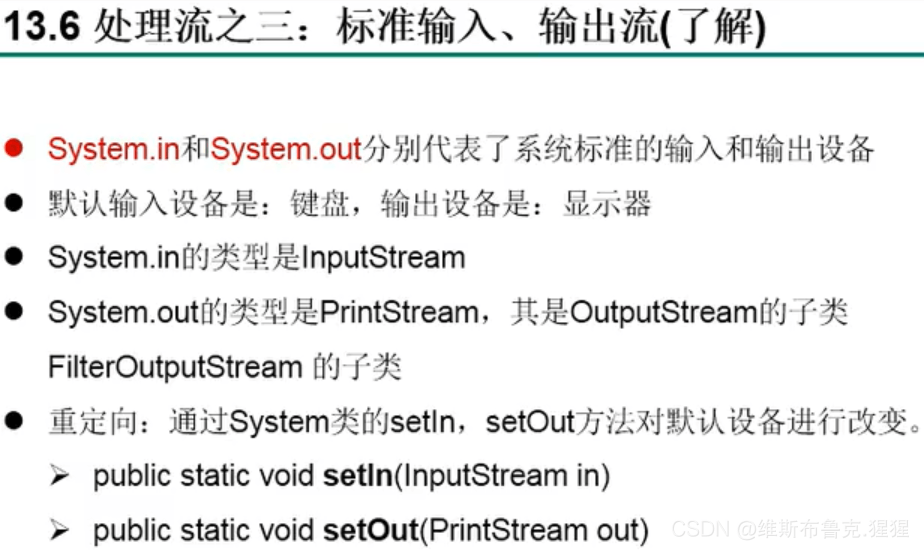
System.out:标准的输入流,默认从控制台输出
1.2System类的setIn() / setOut()方式重新指定输入和输出的流。
修改默认的输入和输出行为:
System类的setIn(InputStream is) / setOut(PrintStream ps)方式重新指定输入和输出的流。
1.3练习:
从键盘输入字符串,要求将读取道德整行字符串转换成大写输出。然后继续进行输入操作。
直至当输入"e"或"exit"时,退出程序
方法一:使用Scanner实现,调用next()返回一个字符串
方法二:使用System.in实现。System.in ---> 转换流 -->BufferedReader的readLine()
public static void main(String[] args) {
BufferedReader br = null;
try {
InputStreamReader isr = new InputStreamReader(System.in);
br = new BufferedReader(isr);
while(true){
System.out.println("请输入字符串:");
String data = br.readLine();//调用此方法读取一行数据
if("e".equalsIgnoreCase(data) || "exit".equalsIgnoreCase(data)){//避免空指针的写法,之前有
System.out.println("程序结束");
break;
}
String upperCase = data.toUpperCase();
System.out.println(upperCase);
}
} catch (IOException e) {
e.printStackTrace();
} finally {
if(br != null){
try {
br.close();
} catch (IOException e) {
e.printStackTrace();
}
}
}
}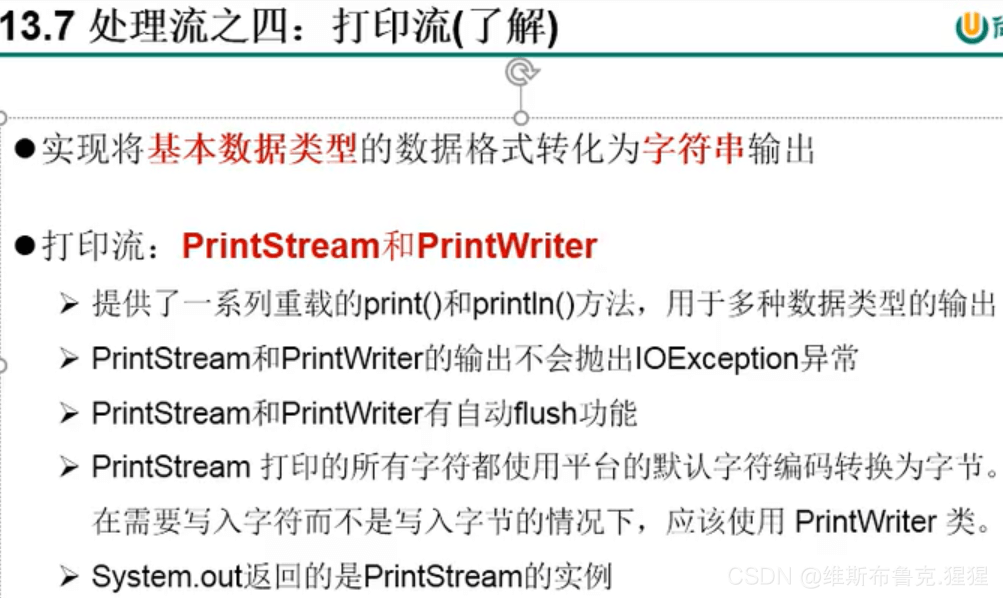

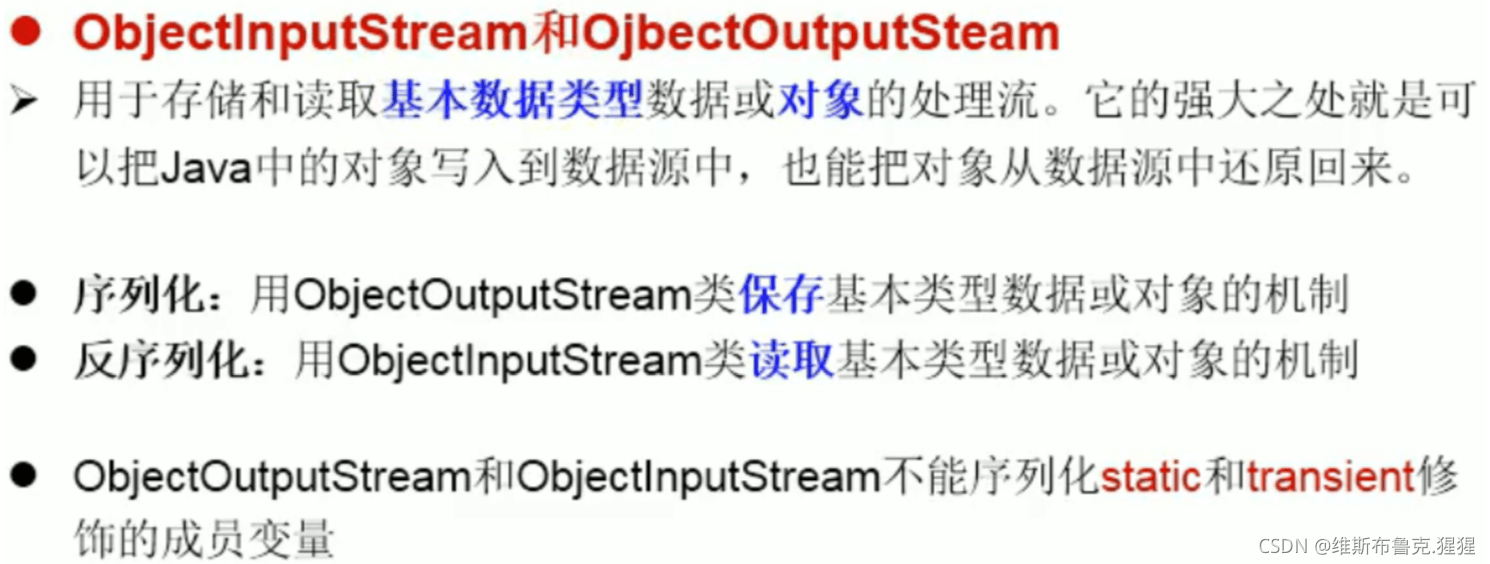
1.ObjectInputStream和ObjectOutputStream
2.作用:用于存储和读取基本数据类型或对象的处理流。
3.要想一个Java对象是可序列化的,需要满足相应的要求。见Person.java
4.序列化机制:(重点!!!!)
对象序列化机制允许把内存中的Java对象转换成平台无关的二进制流,从而允许把这种二进制流持久的保存在磁盘上,或通过网络将这种
二进制流传输到另一个网络节点,当其他程序获取了这种二进制流,就可以恢复成原来的Java对象
序列化过程:将内存中的java对象保存到磁盘中或通过网络传输出去
使用ObjectOutputStream实现
@Test
public void testObjectOutputStream(){
ObjectOutputStream oos = null;
try {
oos = new ObjectOutputStream(new FileOutputStream("object.dat"));
oos.writeObject(new String("我爱北京天安门"));
oos.flush();//刷新操作
oos.writeObject(new Person("王铭",23));
oos.flush();
} catch (IOException e) {
e.printStackTrace();
} finally {
if(oos != null){
try {
oos.close();
} catch (IOException e) {
e.printStackTrace();
}
}
}
}
反序列化:将磁盘文件中的对象还原为内存中的一个Java对象
使用ObjectInputStream来实现
@Test
public void testObjectInputStream(){
ObjectInputStream ois = null;
try {
ois = new ObjectInputStream(new FileInputStream("object.dat"));
Object obj = ois.readObject();
String str = (String) obj;
Person p = ois.readObject();
System.out.println(str);
System.out.println(p);
}catch(IOException e){
e.printStackTrace();
}catch(ClassNotFoundException e){
e.printStackTrace();
}finally {
if(ois != null){
ois.close;
}
}
}Person需要满足如下的要求,方可序列化
1.需要实现接口:Serializable
2.当前类提供一个全局常量:serialVersionUID
3.除了当前Person类需要实现Serializable接口之外,还必须保证其内部所有属性也必须是可序列化的(默认情况下,基本数据类型、String:本身是可序列化的)
补充:ObjectOutputStream 和 ObjectInputStream不能序列化static和transient修饰的成员变量
eg:输出结果:Person{name='null',age=0,id=0,acct=null}
public class Person implements Serializable{
public static final long serialVersionUID = 397497937034L;
private String name;
private int age;
@Override
public String toString() {
return "Person{" +
"name='" + name + '\'' +
", age=" + age +
'}';
}
public String getName() {
return name;
}
public void setName(String name) {
this.name = name;
}
public int getAge() {
return age;
}
public void setAge(int age) {
this.age = age;
}
public Person(String name, int age) {
this.name = name;
this.age = age;
}
public Person() {
}
}

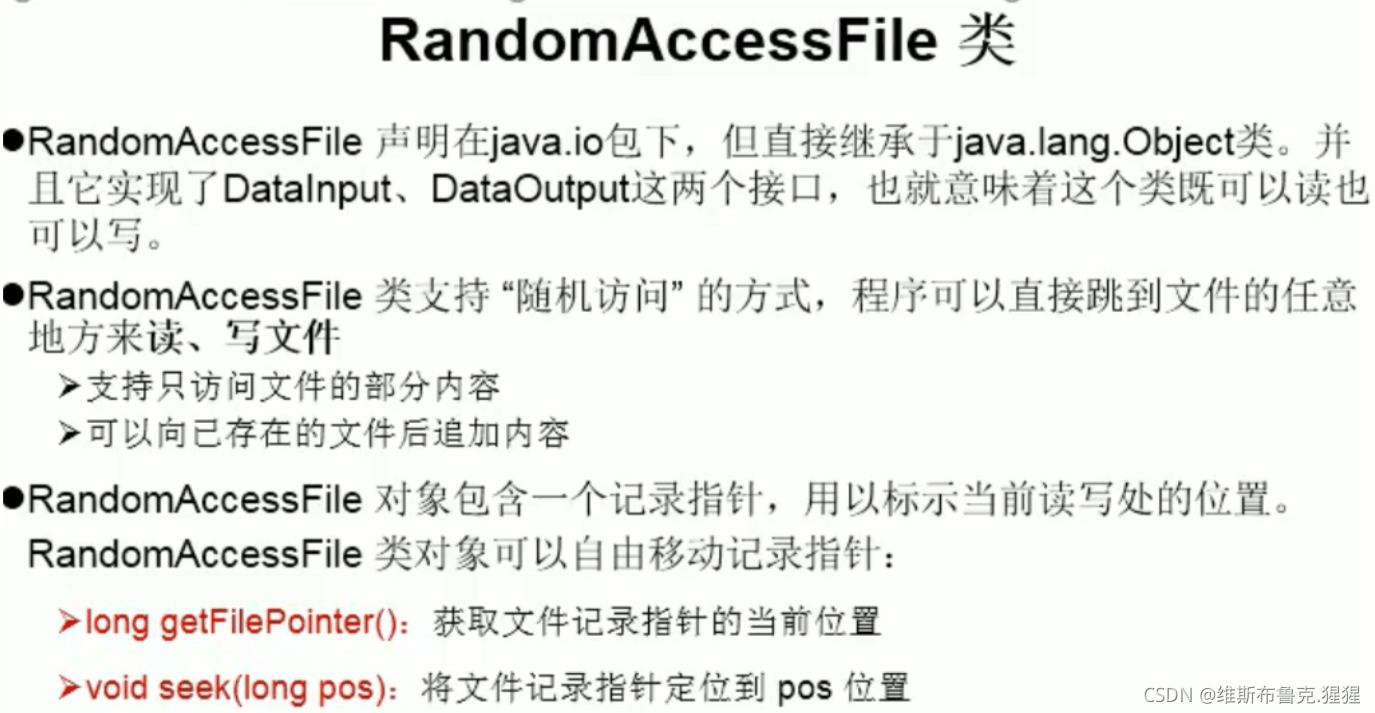



RandomAccessFile
1.RandomAccessFile直接继承于java.lang.Object类,实现了DataInput和DataOutput接口
2.RandomAccessFile既可以作为一个输入流,又可以作为一个输出流
3.如果RandomAccessFile作为输出流时,写出到的文件如果不存在,则在执行过程中自动创建
如果写出到的文件存在,则会对原有文件内容进行覆盖,(默认情况下,从头覆盖)
4.可以通过相关的操作,实现RandomAccessFile"插入"数据的效果
public abstract class RandomAccessFileTest {
@Test
public void test1(){
RandomAccessFile raf1 = null;
RandomAccessFile raf2 = null;
try {
raf1 = new RandomAccessFile(new File("爱情与友情.jpg"), "r");
raf2 = new RandomAccessFile(new File("爱情与友情1.jpg"), "rw");
byte[] buffer = new byte[1024];
int len;
while((len = raf1.read(buffer)) != -1){
raf2.write(buffer,0,len);
}
} catch (IOException e) {
e.printStackTrace();
} finally {
if(raf1 != null){
try {
raf1.close();
} catch (IOException e) {
e.printStackTrace();
}
}
if(raf2 != null){
try {
raf2.close();
} catch (IOException e) {
e.printStackTrace();
}
}
}
}
@Test
public void test2()throws IOException{
RandomAccessFile raf1 = new RandomAccessFile("hello.txt","rw");
raf1.seek(3);//将指针调到角标为3的位置
raf1.write("xyz".getBytes());//
raf1.close();
}
使用RandomAccessFile实现数据的插入效果
@Test
public void test3() throws IOException{
RandomAccessFile raf1 = new RandomAccessFile("hello.txt", "rw");
raf1.seek(3);//将指针调到角标为3的位置
//保存指针3后面的所有数据到StringBuilder中
StringBuilder builder = new StringBuilder((int) new File("hello.txt".length()));
byte[] buffer = new byte[20];
int len;
while((len = raf1.read(buffer)) != -1){
builder.append(new String(buffer,0,len));
}
//调回指针,写入"xyz"
raf1.seek(3);
raf1.write("xyz".getBytes());
//将StringBuilder中的数据写入到文件中
raf1.write(builder.toString().getBytes());
raf1.close();
}
}
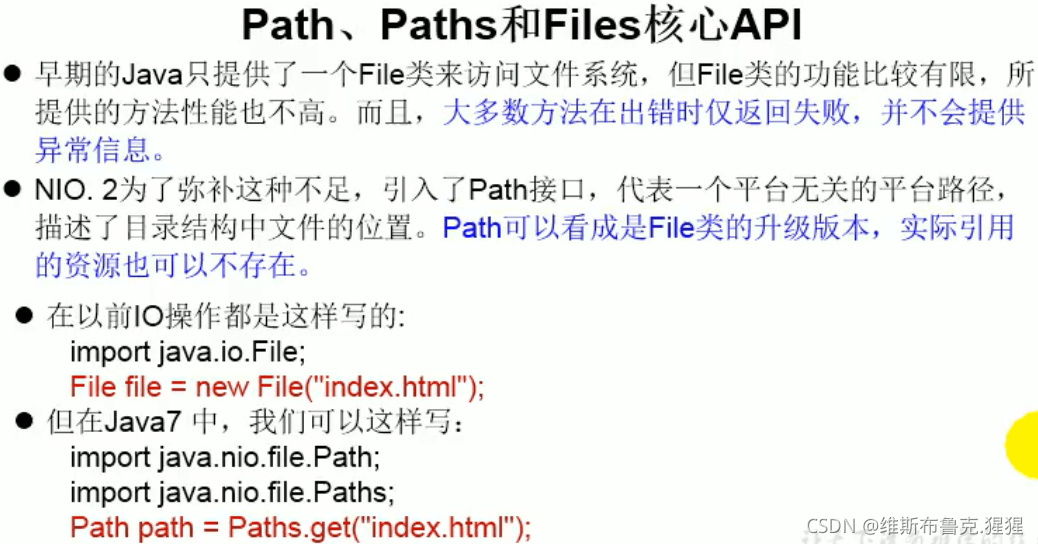

关于“Java中流怎么用”这篇文章就分享到这里了,希望以上内容可以对大家有一定的帮助,使各位可以学到更多知识,如果觉得文章不错,请把它分享出去让更多的人看到。
亿速云「云服务器」,即开即用、新一代英特尔至强铂金CPU、三副本存储NVMe SSD云盘,价格低至29元/月。点击查看>>
免责声明:本站发布的内容(图片、视频和文字)以原创、转载和分享为主,文章观点不代表本网站立场,如果涉及侵权请联系站长邮箱:is@yisu.com进行举报,并提供相关证据,一经查实,将立刻删除涉嫌侵权内容。